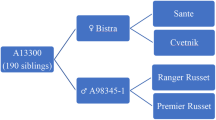Summary
The interaction between flax rust,Melampsora lini, and its host, flax,Linum usitatissimum, has been extensively studied, and certain genetic features make the system an appropriate choice to utilize in isolating genes conferring avirulence in rust. A mutant that was selected for virulence on Lx plants was isolated, after treatment with gamma rays, from a strain that is genotypicallyA-L5,A-L6,A-L7,A-Lx/A-L5,A-L6,a-L7,a-Lx. These four specificities are tightly linked. Breeding tests showed that this mutant was genotypicallyA-L5,A-L6,a-L7,a-Lx/a-L5,a-L6,a-L7,a-Lx and, when made homozygous for the mutant chromosome, was virulent onL5,L6,L7, andLx. This result excludes somatic recombination as a source of the mutation and indicates deletion as a likely cause. A 250 bp genomic sequence from a strain of rust homozygous for these four linked avirulence genes (A-L5,A-L6,A-L7,A-Lx) was isolated, using a method that allows the differential cloning of the specific DNA sequences located within a deletion in the mutant genome. This clone hybridized to two EcoRI bands in genomic DNA from the strain homozygous for the four linked avirulence genes and from the strain homozygousA-L5 andA-L6 and heterozygousA-L7 andA-Lx, but showed no homology to DNA from the strain carrying the putative chromosomal deletion. The correlation between the genetically characterized deletion mutation and the isolation of a sequence from within a region of chromosome missing from this strain of rust suggests that this 250 bp tract may be part of, or closely linked to, the defined set of avirulence genes.
Similar content being viewed by others
References
Abel PP, Nelson RS, De B, Hoffmann N, Rogers SG, Fraley RT, Beachy RN (1986) Delay in disease development in transgenic plants that express the tobacco mozaic virus coat protein gene. Science 232:738–743
Bennetzen JL, Qin MM, Ingels S, Ellingboe AH (1988) Allelespecific andMutator-associated instability at theRp1 disease resistance locus of maize. Nature 332:369–370
Flor HH (1956) Mutations in flax rust induced by ultraviolet radiation. Science 124:888–889
Flor HH (1958) Mutation to wider virulence inMelampsora lini. Phytopathology 48:297–301
Flor HH (1971) Current status of the gene-for-gene concept. Ann Rev Phytopathol 9:275–296
Gabriel DW, Burges A, Lazo GR (1986) Gene-for gene interactions of five cloned avirulence genes fromXanthomonas campestris pv malvacearum with specific resistance genes in cotton. Proc Natl Acad Sci USA 83:6415–6419
Gerlach WL, Llewellen D, Haseloff J (1987) Construction of a plant disease resistance gene from the satellite RNA of tobacco ringspot virus. Nature 328:802–805
Harrison BD, Mayo MA, Baulcombe DC (1987) Virus resistance in transgenic plants that express cucumber mozaic virus satellite RNA. Nature 328:799–802
Holmes DS, Quigley M (1981) A rapid boiling method for the preparation of bacterial plasmids. Anal Biochem 114:193–197
Jones DA (1988) Genetic properties of inhibitor genes in flax rust which alter avirulence to virulence on flax. Phytopathology 78:342–344
Jordan EG, Timmis JN, Trewavas AJ (1980) The plant nucleus. In: Tolbert N (ed) The biochemistry of plants, a comprehensive treatise, vol 1, Plant cell. Academic Press, New York, pp 489–588
Kohne DE, Levison SA, Byers MJ (1977) Room temperature method for increasing the rate of DNA reassociation by many thousand-fold: the Phenol Emulsion Reassociation Technique. Biochemistry 16:5329–5341
Kunkel LM, Monaco AP, Middlesworth W, Ochs HD, Latt SA (1985) Specific cloning of DNA fragments absent from the DNA of a male patient with an X-chromosome deletion. Proc Natl Acad Sic USA 82:4778–4782
Lamb CJ, Lawton MA, Dron M, Dixon RA (1989) Signals and transduction mechanisms for activation of plant defences against microbial attack. Cell 56:215–224
Lawrence GJ (1987)Melampsora lini, rust of flax and linseed. In: Sidhu GS (ed) Genetics of plant pathogenic fungi. Academic Press, New York, pp 313–331
Lawrence GJ, Mayo GME, Shepherd KW, (1981) Interactions between genes controlling pathogenicity in the flax rust fungus. Phytopathology 71:12–19
Mayo GME, Shepherd KW (1980) Studies of genes controlling specific host-parasite interactions in flax and its rust. I. Fine structure analysis of theM group in the host. Heredity 44:211–229
Michelmore RW, Hulbert SH (1987) Molecular markers for genetic analysis of phytopathogenic fungi. Annu Rev Phytopath 25:383–404
Norrander J, Kempe T, Messing J (1983) Construction of improved M13 vectors using ologodeoxynucleotide-directed mutagenesis. Gene 26:101–106
O'Dell M, Wolfe MS, Flavell RB, Simpson CG, Summers RW (1989) Molecular variation in populations ofErysiphe graminis on barley, oats, and rye. Plant Pathol 38:340–351
Shepherd KW, Mayo GME (1972) Genes conferring specific plant disease resistance. Science 175:375–380
Soliday CL, Flurky WH, Okita TW, Kolattukudy KS (1984) Cloning and structure determination of cDNA for cutinase, an enzyme involved in fungal penetration of plants. Proc Natl Acad Sci USA 81:3939–3943
Southern EM (1975) Detection of specific sequences among DNA fragments separated by gel electrophoresis. J Mol Biol 98:503–517
Staskawicz BJ, Dahlbeck D, Keen NT (1984) Cloned avirulence gene ofPseudomonas syringae pv glycinea determines racespecific incompatibility onGlycine max (L.) Merr. Proc Natl Acad Sci USA 81:6024–6028
Staskawicz BJ, Dahlbeck D, Keen N, Napoli C (1987) Molecular characterization of cloned avirulence genes from Race 0 and Race 1 ofPseudomonas syringae pv glycinea. J Bacteriol 169:5789–5794
Weltring K-M, Turgeon BG, Yoder OC, VanEtten HD (1988) Isolation of a phytoalexin-detoxification gene from the plant pathogenic fungusNectria haematococcus by detecting its expression inAspergillus nidulans. Gene 68:335–344
Author information
Authors and Affiliations
Additional information
Communicated by G. Wenzel
Rights and permissions
About this article
Cite this article
Timmis, J.N., Whisson, D.L., Binns, A.M. et al. Deletion mutation as a means of isolating avirulence genes in flax rust. Theoret. Appl. Genetics 79, 411–416 (1990). https://doi.org/10.1007/BF01186087
Received:
Accepted:
Issue Date:
DOI: https://doi.org/10.1007/BF01186087




